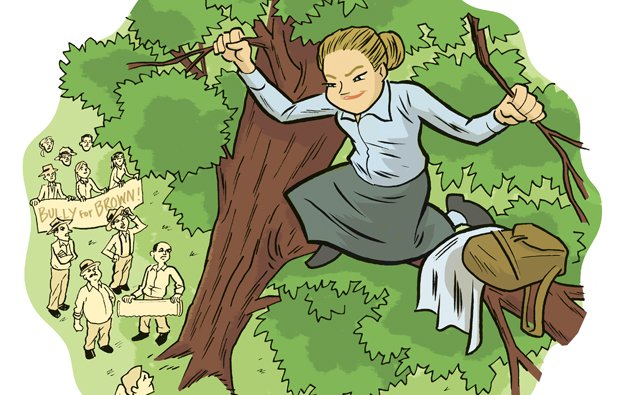A treetop gambit by Shenandoah Greens

Saving the Shade – Feature
25 YEARS AGO – In New Market, Edinburg and Strasburg, the State Highway Commission had destroyed trees to widen thoroughfares, but in Woodstock, when the state went after the mountain greenery, some residents went out on a limb. In June 1935, the Clarke-Lewis Construction Co. arrived under state contract to chop some trees on Main Street in the Shenandoah County town. The official word was that only several trees had to go, but when residents woke up one morning to see a large number of trees marked for destruction, they barked.
One of them, Charlotte Francis Stephens, widow of Phineas Stephens, an engineer behind the illumination of Endless Caverns, got an injunction from Judge Philip Williams at Winchester to save her trees. Nevertheless, one of her trees was felled the next day. The contractors, who were not named in the injunction, had proceeded with their task.
Tensions then climbed when Lorraine French Brown, daughter of Woodstock financier William French and sister of county Republican leader Warren French, went up a maple in front of her home and dared the cutters to cut. Her audacious gambit succeeded “in saving the shade,” wrote the Shenandoah Valley newspaper. Judge Williams issued an injunction prohibiting the cutting of the Brown trees.
The Woodstock tree affair was the top story in Virginia for the first half of ’35, wrote the Valley. Every paper in the country with access to the Associated Press wire carried stories on the “tree war,” and those with Wirephoto service ran images of Brown as she “kept her vigil at the treetop.”
Resident Samuel Hepner filed criminal charges for destruction of a tree in front of his place, and two Clarke-Lewis employees were fined $10 apiece for trespassing. In his remarks after fining the men, another judge said that he was “out of sympathy with the tendency of officials to arbitrarily assume authority outside of the provisions of the law” and that property owners were entitled to ample notice before their property was to be destroyed or taken.
Surprise! Several weeks later, the injunctions were dissolved. The courtroom was packed, mostly with women whom the Valley said were “highly indignant on the tree-cutting question” (Brown more highly than others). In his decision, Judge Williams acknowledged the controversy inherent in any highway construction. “It may be that too much emphasis has been placed upon the highways and too little to the beauty of its borders,” he wrote, adding: “The ugliest distance between two points is often a straight line.”








